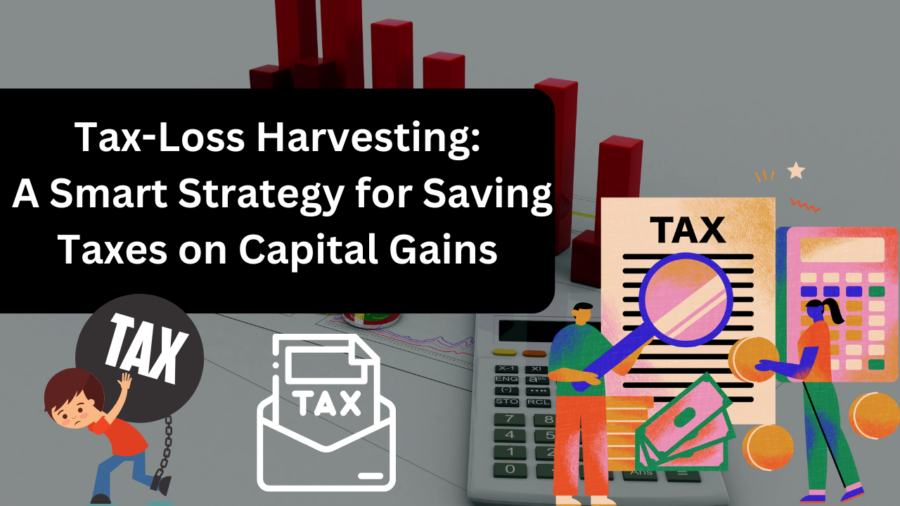Tax-loss harvesting becomes a key feature to optimise your tax outgo, as in the world of investing, capital gains taxes are an inevitable reality. Whether you’re selling stocks, real estate, or other assets, the government wants its share of your profits.
Previously, the long-term capital gains (LTCG) made on the sale of equity shares, and equity funds were completely tax-free in your hands. However, the amendment made in the Union Budget 2018 has changed the tax treatment of LTCG on the sale of listed equity shares and equity funds.
Beginning from 23 July 2024, an LTCG of more than Rs 1.25 lakh is taxed at a rate of 12.5% without the benefit of indexation. Compared to that, short-term capital gains (STCG) are taxed at a rate of 20%.
But with some smart planning and strategic moves, you can significantly reduce your tax burden and keep more of your hard-earned money. Welcome to the art and science of maximizing your profits through savvy tax-saving strategy known as tax-loss harvesting.
Understanding Capital Gains Tax
Is there any way to reduce tax outgo on my investments? I keep getting lots of queries from small and big investors as to how do we ensure tax-saving while dealing with capital gains on sale of shares and mutual funds. Though there are many options which can be used to lower tax outgo on both long term and short term capital gains, this article will focus on tax-loss harvesting.
What is Tax–Loss Harvesting?

Whenever you invest in equity funds and make profit by selling them, this profit is called capital gains. These capital gains are taxable based on how long you stayed invested in that fund.
However, not all our investment decisions are profitable, and there is a tendency to hold on to loss-making investments in the hope of a turnaround. It is these loss-making investments that can be sold and used as profit-slicing instruments to lower the net tax outgo. This strategy is called tax loss harvesting. It starts with the sale of the stock or an equity fund that is experiencing a consistent price decline. You feel that the security has lost most of its value and the chances of a rebound are bleak.
By realizing losses, you reduce your taxable capital gains by offsetting gains from other investments. If qualified loss is more than the adjustable capital gains for that year, the remaining loss can be carried forward for offsetting the gains of future years.
You can employ tax-loss harvesting to reduce the tax liability on long-term capital gains (LTCG) and short-term capital gains (STCG). Usually, investors use it for STCG because the tax rates on short-term capital gains are higher than those of long-term capital gains.
How does Tax-Loss Harvesting work?
Most of the investors prefer using this strategy at the end of the financial year. But I advise investors to use the strategy throughout the year in a planned manner to keep the capital gains at a relatively lower level.

Example of Tax-loss harvesting
Let’s understand this with an example:
Let’s assume that in a given financial year your portfolio made an STCG and LTCG of Rs 1,00,000/- and Rs 1,30,000/- respectively. You also had short-term capital losses of Rs 50,000/-.
Tax payable (Without tax loss harvesting) :
[(1,00,000 * 20%) + {(1,30,000-1,25,000)*12.5%}] = Rs 20,625/-Tax payable (with tax loss harvesting):
[{(1,00,000-50,000)*20%)} + {(1,30,000-1,25,000)*12.5%}] = Rs 10,625/-The amount realized from the sale of the loss-making stock/equity fund can now be used to buy a lucrative stock/equity fund. This kind of replacement/reallocation is also necessary to maintain the original asset allocation of the portfolio.
One needs to remember that tax-loss harvesting doesn’t help to nullify the losses; instead, it is a vital tool to reduce your suffering by helping you save taxes. Moreover, it keeps the portfolio’s risk-return profile intact. Additionally, you have the option to diversify your portfolio to earn higher returns. If you plan to repurchase a similar investment to maintain your investment strategy, you can do so on the same day, as in India there is no restriction on repurchase of an asset class.
While setting off losses using tax-loss harvesting, you need to keep the following points in mind:
- Long-term capital losses can be set off only against long-term capital gains. You cannot set off long-term capital losses against short-term capital gains.
- Short-term capital losses can be set off against either short-term capital gains or long-term capital gains.
Key Points to Remember for Tax-Loss Harvesting
- Tax-loss harvesting can be especially effective in volatile markets where some investments may have temporarily lost value. By strategically realizing losses, you can minimize your tax liability while staying invested in the market. So next time when the market tumbles, look for the opportunities of tax-loss harvesting.
- Maximizing your profits while minimizing capital gains tax requires a combination of strategic planning, informed decision making, a thorough understanding of tax regulations and timely execution. By employing strategies such as tax loss harvesting you can significantly reduce your tax burden and keep more of your hard-earned money.
- Remember, every individual’s financial situation is unique, so it’s essential to consult with a tax professional or financial advisor to develop a personalized strategy that aligns with your specific goals and circumstances. By taking a proactive approach to tax planning, you can maximize your profits and achieve greater financial success.
Read More Blogs : NEW CAPITAL GAINS TAX RATES: FROM CONFUSION TO CLARITY


[…] Read more blogs https://sssfinserv.com/tax-loss-harvesting-a-smart-tax-saving-strategy/ […]
[…] more blogs: tax-loss-harvesting-a-smart-tax-saving-strategy […]
I’m really inspired with your writing abilities as neatly as with the format in your weblog. Is this a paid topic or did you customize it your self? Either way stay up the excellent high quality writing, it’s rare to see a great weblog like this one today!
Thank you for your kind words. Appreciate it. The contents on this site are created in-house and are not paid weblogs.